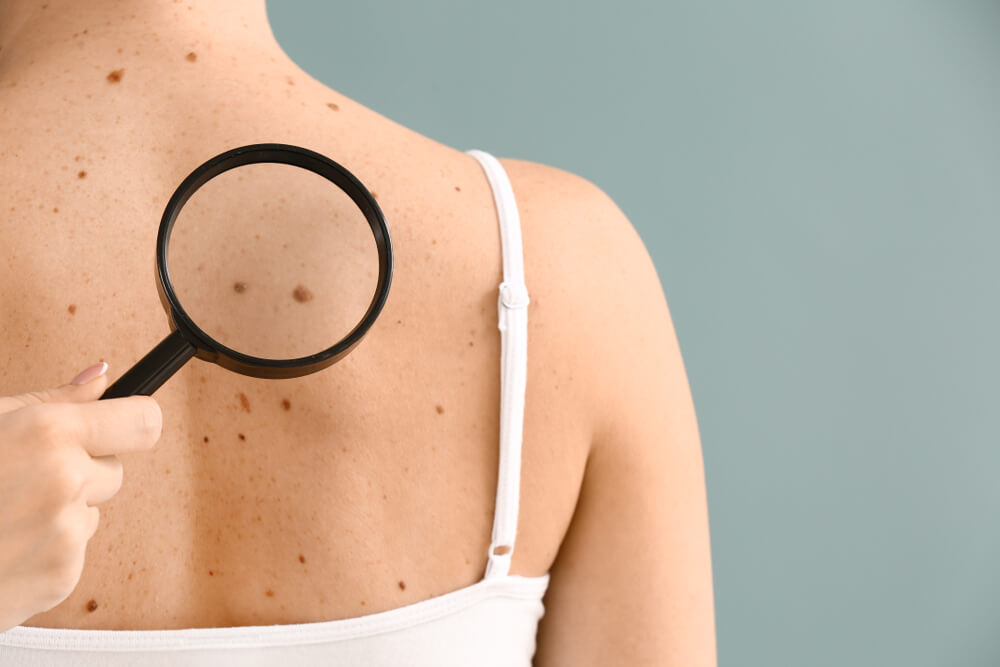Moles are also called beauty marks and nevi from Latin. Normal moles are very common, and for the most part, they are absolutely harmless. They can last up to 50 years and shouldn’t be something of concern.
However, when you discover a suspicious mole, especially one that hurts, bleeds, or is itchy, you should see your doctor or dermatologist to rule out any serious conditions.
Abnormal moles may be the early signs of severe diseases such as melanoma. If you suspect you might have developed melanoma due to an itchy mole, feel free to reach out to Omar Rashid, MD, who can help you establish a proper diagnosis, and, if needed, provide appropriate melanoma and skin cancer management.
However, before we’d jump to hasty conclusions, let’s discuss the different types of moles and what sets apart normal moles from suspicious ones.
What is a Normal Mole?
Skin moles are harmless growths on the skin that can be tan, black, or brown. They can appear wherever on the mucous membranes and the skin, sometimes even in groups.
Most normal moles appear in childhood and may last up to 50 years. It’s entirely normal for somebody to have moles on their body ranging between ten to 40.
Some moles may change over time and even disappear as we age.
Moles usually most often occur when the melanocytes in your skin grow in clusters instead of spreading out evenly throughout the skin. Melanocytes are the cells that give your skin its color.
Normal moles often get darker due to UV exposure, and the longer you stay under the sun, the more moles you might develop.
Typically, there are no itchy moles on your body. Painful moles are also rare, and they shouldn’t bleed. Whenever you experience these problems with them, schedule an appointment with your doctor or dermatologist to rule out any severe conditions.
Types of Moles

Generally speaking, there are three types of moles. They are:
- Common Nevi: These are normal moles, around average size (about a quarter-inch in diameter), ranging from pink, tan, brown, or black, with distinct borders.
- Congenital Nevi: These are on the skin since birth and are more likely to develop into melanoma.
- Dysplastic Nevi: These moles have irregular shapes to them, uneven color, and edges. They can be hereditary, and some people may have over 100 of them. Dysplastic nevi also have a tendency to develop into melanoma.
What are Pigmented Lesions
Pigmented lesions refer to a generalized term that includes normal moles, age spots, and/or sun freckles. By default, pigmented lesions are benign, but any unusual changes should raise concern.
As such, it’s always a good idea to get any suspicious moles or itchy moles checked, together with other dermatologic changes.
In the case of such “suspicious” changes, your doctor might recommend a skin biopsy, removing a sample of the lesion to examine it in more detail.
When to Check a Suspicious Mole?
As already mentioned above, most normal moles won’t cause any problems. However, in order to protect yourself from dangerous diseases such as skin cancer, it’s a smart idea to inspect your skin and pigmented lesions for any changes regularly. This is especially important if you have:
- A family history of skin cancer
- Fair skin
- Several moles on your body
- Spend much time in the sun or in tanning booths
Most skin experts will advise examining your skin on a monthly basis. Look for suspicious moles that change their appearance, shape, and color. If you locate an itchy, bleeding, or painful mole, don’t hesitate to get it evaluated by a professional.
What Should You Look for?
For the most part, you should look suspicious moles that look different from the existing moles on your skin or those that appeared on your body after you’ve turned 30. As mentioned before, look for changes in size, color, thickness, and shape. Painful and itchy moles should also raise concerns, especially if they bleed, ooze, or scale.
Make sure to follow the ABCDE method when performing the self-exam:
- Asymmetry: the suspicious mole has uneven halves.
- Border: Irregular, blurred, or ragged mole edges should all be of concern.
- Color: if the color is also uneven or the suspicious mole has several colors shades like black, brown, red, white, blue – consult with an expert
- Diameter: The mole shouldn’t be larger than ¼ inches.
- Evolution: the suspicious mole changes its size, color, and shape quickly.
In the end, your dermatologist will be the one to determine whether a mole is suspicious or not. Normal moles will be left untreated as their removal will only leave a scar.
As mentioned above, suspicious moles will be further examined through a skin biopsy. The diagnosis won’t take more than a week, and if a severe condition, such as melanoma, is found, the mole will be removed through surgery, and other treatments may also be required to treat the malignancy entirely.
Treating Moles
As said before, normal moles will need no treatment and shouldn’t be removed. Still, you can choose to have them removed, but it will most likely leave a scar.
Also, don’t try self-treatment when it comes to mole removal. Stay away from OTC products that might freeze, burn, or remove the mole or other skin growths with the use of lasers. If you do so, you are running the risk of getting an infection and hurting yourself.
Lastly, you might remove a suspicious mole that’s cancerous. Even when removed, the cancerous growth needs professional attention because experts need to assess the state of the disease to treat it successfully.
Can You Prevent Moles?

Simply put, moles can’t be prevented. Instead, you should put more effort into protecting yourself from skin cancer by having the following proactive approach:
- Limiting sun exposure and tanning bed use
- Wearing sunscreen whenever outside
- Performing monthly self-exams
The key here is to be proactive, especially if you have:
- Several moles in your skin
- Have fair skin
- Have a family history of melanoma
Especially be vigilant about the moles that appear after you’ve turned 30. Many of these lesions will be harmless. However, make sure to keep tabs on new growths and visit a professional as soon as you notice any irregularities with them.
Also, you should know that moles can either be cutaneous or mucosal, meaning they can develop on the skin or in the genitals, mouth, and eyes. Often, melanoma may be hidden, developing in said mucosal areas. As such, apart from regular self-examinations, you should also visit an expert for an annual checkup to make sure everything’s right.
Don’t Be Afraid but Be on the Lookout
For the most part, moles are totally harmless and lead to no complications. Still, some of them may turn cancerous and cause melanoma. Moles can last for up to 50 years but might disappear on their own as time progresses.
Living with them shouldn’t be a problem, and you shouldn’t treat your moles any different than the rest of your skin.
Still, if you experience any irregularities regarding mole shapes, sizes, and colors on your skin, feel free to reach out to our practice as well so we can rule out any severe problems in time.

